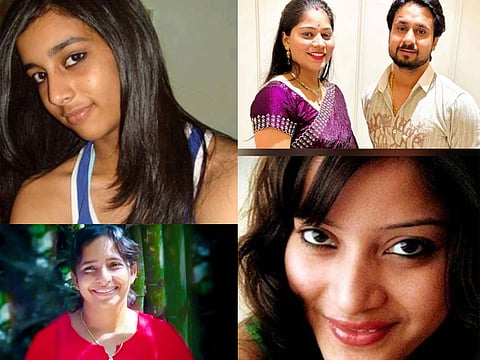Meghalaya honeymoon murder case: A look at gruesome true crime cases that shook India
Warning: These disturbing cases of cold-blooded killings continue to horrify and haunt us

Dubai: While the recent Meghalaya honeymoon murder case, where a young groom was allegedly murdered by his bride, has sent shivers across the country, it’s far from the first time India has been gripped by cold-blooded killings that feel straight out of a psychological thriller.
Before true crime podcasts and Netflix thrillers took off, India was rocked by several real-life horror cases such as the tragic Tandoor murder case in 1995. It had everything—political power, jealousy, a botched cover-up, and forensic breakthroughs that changed the course of Indian criminal investigations forever.
Here's a closer look at some of the most disturbing and headline-grabbing murder cases that continue to shock, confuse, and horrify.
1. Shraddha Walkar case (Delhi, 2022)
The horror: Shraddha, a 26-year-old woman, was murdered by her live-in partner Aaftab Poonawala in Delhi. He strangled her, then cut her body into 35 pieces with a saw, stored them in a fridge, and disposed of them in Mehrauli forest over several nights.
Why it shocked us: The sheer calculation, the use of dating apps post-murder, and his complete lack of remorse. Think real-life Dexter, minus any moral code.
2. Sheena Bora murder case (Mumbai, 2012; exposed 2015)
The secret: Sheena Bora was allegedly murdered by her mother, Indrani Mukerjea, in a twisted tale of family secrets, power, and identity theft. Indrani had introduced Sheena as her sister for years.
The twist: Indrani, a former media mogul and socialite, allegedly conspired with her driver and ex-husband to kill her daughter and burn the body in a forest. The case came to light when the driver confessed during a separate arrest.
Why it shocked us: The chilling web of lies, elitism, and a mother allegedly killing her daughter to "protect her image."
3. Nagpur ritual killing case (2023)
The killer: Bharat Kalicharan, aka “Doctor Death,” claimed to be a healer and confessed to killing multiple women over several years under the guise of healing rituals.
What makes it worse: Some reports hinted at cannibalistic tendencies and detailed how he kept body parts for spiritual ceremonies.
Why it shocked us: It exposed how superstition, vulnerability, and ritual violence can be manipulated into horror beyond fiction.
4. 🪢 Burari Deaths (Delhi, 2018)
The scene: Eleven family members were found dead in their home. Ten were hanging from the ceiling, blindfolded, gagged, and hands tied. The eldest matriarch was found strangled.
What really happened: Investigators uncovered handwritten “ritual notes” spanning years, believed to be written by one family member under a delusion of being spiritually guided by his deceased father.
Why it shocked us: Initially thought to be murder or a mass suicide pact, the case unraveled into a complex mix of shared psychosis and blind faith gone terribly wrong.
5. Nithari Killings (Delhi, 2016)
What happened: In 2006, police made a sickening discovery—human remains and children’s clothes were found in a drain outside Moninder Singh Pandher’s upscale bungalow in Noida. The gruesome trail led straight to the house. One of India’s most disturbing and gruesome murder cases—the Noida serial killings— took a shocking turn nearly two decades later
Victims: At least 19 women and children, mostly from nearby slums, were believed to have been lured, raped, murdered, and dismembered.
Shock factor: The discovery of skulls, bones, and severed body parts scattered across the backyard and drain turned a missing persons investigation into one of India’s darkest true crime sagas. The two men arrested—Surinder Koli, a domestic worker, and Moninder Singh Pandher, his wealthy employer—were convicted in multiple cases, with Koli handed several death sentences and Pandher convicted in two. Koli was accused of carrying out the murders inside Pandher’s home, while the businessman claimed ignorance. The case became symbolic of class disparity, police apathy, and the vulnerability of India’s poor. But in a stunning twist, the Allahabad High Court in 2023 acquitted both men—Koli in 12 cases and Pandher in both—citing a lack of evidence. The acquittal has triggered new questions about the integrity of the original investigation, the media frenzy that followed, and whether justice was ever truly served for the young lives lost in one of India’s darkest true crime sagas.
6. Koodathayi cyanide killings/Jolly Murder case (2019)
What happened: A series of unnatural deaths in Kerala involving six people from the same family over 14 years led to the arrest of Jollyamma Joseph. She used cyanide-laced food like mutton soup to kill all six family members. It's now called the "Kerala cyanide murders"
Shock factor: The alleged murders reportedly began in 2002 with the death of her mother-in-law, Annamma Thomas, followed by her father-in-law, husband, a relative, and finally, the wife and child of her second husband Shaju. Police allege that Jolly’s had multiple motives, eliminating obstacles to wealth, silencing suspicions, and securing a more desirable marriage. Interestingly, Jolly had maintained a facade of respectability, even masquerading as a college lecturer. Despite cyanide being found in her husband Roy’s autopsy, his death was initially considered a suicide. It took more than a decade for the trail of crime to surface.
Sign up for the Daily Briefing
Get the latest news and updates straight to your inbox



